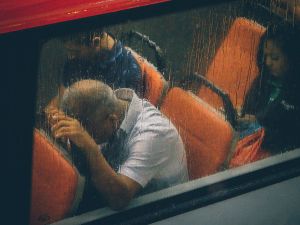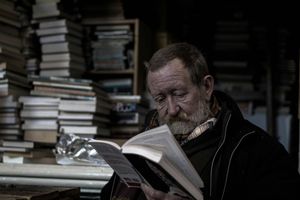Refiguration is the third movement of narrative, the stage in which a story is restored to the real world of action and suffering. It is in the reader that the story reaches its conclusion.

Mimesis 2, emplotment, or configuration, is the most common concern for discussion on narrative but Ricoeur is insistent that in order for mimesis 2 to become intelligible there is a requirement for a third stage to complete the cycle of mimesis.1
This third movement of narrative is the stage in which a story is restored to the real world of action and suffering; it is in the hearer or reader that the mimetic arc reaches its conclusion.2
This means then,
… mimesis 3 marks the intersection of the world of the text and the world of the reader; the intersection, therefore, of the world configured by the poem and the world wherein real action occurs and unfolds its specific temporality.3
Without this third stage, the stage of refiguration, narration is not possible.
A brief aside …
Before progressing to looking at what happens when narratives are restored to the real world of acting and suffering, there’s a couple of important terms that should be briefly described, since they’ll get used a lot.
Ricoeur’s philosophy has always focussed on the human experience and perception of reality, a branch of philosophy called phenomenology. He soon realised that we human beings use language to express our experience of phenomena. The way we interpret and comprehend things expressed in language is a field known as hermeneutics.
In human experience, some phenomena are incomprehensible and overflow with irresolvable internal contradictions. A thing that is incomprehensible and irresolvable is called an aporia and matters related to them are aporetic.
Time, for Ricoeur, is the ultimate aporia and his work here is trying to understand how it is that human beings do not despair when confronted with the sheer vastness of cosmic time. Ricoeur’s intention in Time and Narrative is to understand how we approach the aporetic — time in this case — through language in the form of narrative. For Ricoeur, we engage with the aporetic by humanising it through narrative. Or, in other words:
We tell stories to come to terms with the incomprehensible.
Four problems for restoring narratives
Ricoeur poses four problems to explore the dynamics of refiguration.
Firstly, if the narrative arc begins and ends in the world of action, does this really mark a progression? Have we actually developed our understanding of ourselves and the world at large? Is there not, in fact, a problem of circularity, that stories are just folded in on themselves?
Next, in what way is hearing or reading related to the telling of the story? How does refiguration develop, prolong and conclude the act of emplotment?
Thirdly, the act of reading brings the narrative work into the field of communication. This allows Ricoeur to revisit questions of reference — what happens in communication as language refers to things in the real world? — that he’d examined earlier in his career and to fully examine the particular difficulties of reference in the field of narrative.
Finally, since the narrated world is refiguring a temporal world, it is necessary to examine the capacity for a ‘hermeneutics of narrated time’ (i.e. the way the story reshapes time through the plot) to comprehend the ‘phenomenology of time’, time as it is actually experienced.4
By developing this discussion it is then possible to extrapolate from Ricoeur’s argument on time and narrative to a wider discussion on ‘the relation between a phenomenology that does not stop engendering aporias,’ and what may be called ‘poetic “solutions” to those aporias.’5 The culmination of this discussion, then, is this ‘dialectic between an aporetics and a poetics.’6
Mimetic Circularity

With the movement from prefiguration to refiguration via configuration there is an inevitable concern over circularity, that the ending point is no further from the starting point, or worse still that the end point is already present at the beginning in some way.7 If this were so then all that would exist is a vicious circle of words, no use to anyone.8
Ricoeur concedes that there is a circularity but he does not yield that the circularity is a vicious one.9 Rather he suggests that the mimetic cycle is a never-ending spiral of ever-increasing understanding, passing the same point many times but each time at a different ‘altitude.’10 A story may be about despair, or fidelity, say, and each time it returns to the theme through the characters, the actions, the events, the story has provoked the reader to understand more and more about despair, or fidelity.
The cycle of a story is a never-ending spiral of ever-increasing understanding, passing the same point many times but each time at a different altitude.
Ricoeur proposes several images to illustrate his rejection of circularity. Most immediately, human beings have an extraordinary capacity to identify narrative traits in sequences of episodes in everyday life. We are inclined to see, oxymoronically, ‘“(as yet) untold” stories.’11 Surely a story is defined in part as something that is told? And yet we appear to have an innate ability to recognise a story that demands to be told.12
As a second example, the patient tells a psychoanalyst ‘bits and pieces’ of lived experiences, often conflictual, in a process that is designed to draw them together into a narrative structure that can give them greater and greater substance and intelligibility. Each recollection builds the narrative coherence of a life, each time a greater height of understanding.13 Or again, a judge or jury is tasked with trying to ‘untangle’ the layers of narratives in a court case, and each witness gives their account so that the story of the events and subjects can emerge from the melée.
A final illustration is seen vividly in the need to retain the history of the defeated, the losers, the suffering, the marginalised. Even seven decades on from the events themselves, the number of novels and movies that examine the Jewish holocaust of the Second World War is testament to a refigurative mimetic spiral, not an enclosed circle.
‘The whole history of suffering cries out for vengeance and calls for narrative.’14
This is not a one-time narration but a corpus of stories, each member of which compounds, corrects or converts existing comprehension.
The circularity of the mimetic arc is not problematic. Rather it is immensely productive, in that each pass by the ‘point’ of the story deepens its intelligibility. The spiral nature of this circular motion means that, far from being a vicious circle, the hermeneutics of narrative contributes to a healthy circle.15
Configuration, Refiguration and Reading

I described previously that, for Ricoeur, emplotment is the transition between mimesis 1 and mimesis 2. In a similar way, he argues that reading is the transition between mimesis 2 and mimesis 3.
Emplotment is a collaboration between the writer and the reader.
In reading, the reader undertakes to ‘grasp together’ the elements of the plot and construct them into an intelligible whole.16 Emplotment, then, is not the sole domain of the writer but is a collaboration between the writer and the reader (or the teller and the hearer).17 The guidelines of traditionality and schematisation govern the story’s capacity to be followed.
On the other hand, it is the act of reading that accompanies the narrative’s configuration and actualizes its capacity to be followed. To follow a story is to actualize it by reading it.18
This is the joint work of the text and the reader.19
The reader is also the locus within which the narrative innovation of the story is able to be realised.
In the act of reading, the receiver plays with the narrative constraints, brings about gaps … and enjoys … the pleasure of the text.20
And in reading the reader ‘completes’ the work, since the text provides a ‘sketch for reading.’21
Reference

The notion of reading is the beginning of a fully-fledged description of mimesis 3, as far as Ricoeur is concerned. The interaction between the reader and the text demands that both have their feet under the table. A theory of reception (i.e. the ways that stories have been read throughout their history) must, however, also incorporate an understanding of reference if it is to have any merit, for ‘[i]f narrative did not have this referential function, its purpose would be lost, and we would not “understand” it in any deep sense.’22
Ricoeur’s foundational definition of mimesis 3, the ‘intersection of the world of the text and the world of the reader,’23 incorporates the starting point for his examination of reference, that the text projects a ‘world’ that constitutes its ‘horizon.’24
An ability to communicate, the capacity to refer
The ‘world of the text’ is an idea that picks up where The Rule of Metaphor left off. Ricoeur’s earlier project on metaphor had indicated that broadening the view from the word to the sentence enabled the critic to grasp that the primary intention of language is to say something about something to someone.25 The point of saying something, verbally or in writing, is not just to say something to someone but to ‘bring a new experience to language and share it with someone else. It is this experience, in turn, that has the world for its horizon.’26
The primary intention of language is to say something about something to someone.
This means that language does not constitute a world for itself, and it is not a world in itself.27 Rather, because ‘we are in the world and are affected by situations, we try to orient ourselves in them by means of understanding,’ and this we do by bringing experience to language, by having something to say about something to someone.28
Reception thus incorporates simultaneously both an ability to communicate and the capacity to refer.29 In reading a reader receives both the sense of the work and its reference, that is, ‘the experience it brings to language and, in the last analysis, the world and the temporality it unfolds in the face of this experience.’30
The Rule of Metaphor urges us to expand not only from the word to the sentence but also to the whole work. In doing so, similar things can be said about the literary work as a whole, that it brings an experience to language and thereby comes into the world. We can thus speak of the ‘world of the text,’ but this poses the problem of the relation of the world of the text with the world of the reader and the interaction or fusion of two horizons, the question of how literature affects everyday experience.31
The resolution to this problem begins with Ricoeur’s argument in The Rule of Metaphor that:
… ‘language’s capacity for reference was not exhausted by descriptive discourse and that poetic works referred to the world in their own specific way, that of metaphorical reference.’32
A correlation can then be established between the metaphorical notion of ‘seeing as’ and the literary work’s capacity to propose ‘being as,’ i.e. to present a way of being in the world.
In my field of Biblical Studies, in the Parable of the Unforgiving Servant (Matthew 18: 21–35), for example, the king and the servant both present a way of being-in-the-world and the narrative is constructed in such a way that the contrast of those modes of ‘being as’ is of key significance.
Kevin Vanhoozer is wary of the notion of ‘being as,’ concerned that its ambiguity allows Ricoeur to fall down the slippery slope to ‘as if’ that privileges the poetic over the actual and fiction over history.33 As a theologically motivated reader, this makes Vanhoozer nervous because he perceives that it would allow the Gospels to be read as fictions not as histories, even to the point of destabilising a historical root or claims to literality in the canonical narratives of Jesus.34 I shall explore this in further depth in future posts on criticisms of Ricoeur’s theory of narrative, but for now it raises a question about whether Ricoeur privileges fiction over history.

The metaphoric quality of poetic works, including narratives, means that the world of the text includes descriptive and non-descriptive references. The point of this is not that hermeneutics should expose the author’s intention behind the text but that it exposes the ‘movement by which the text unfolds, as it were, a world in front of itself.’35
For example, in recent times there has been a substantial number of books, films and TV series that re-examine Tudor England, with Hilary Mantel’s Wolf Hall and Philippa Gregory’s The Other Boleyn Girl being notable examples. These stories characteristically approach well-known stories from the viewpoint of fairly ordinary people who find themselves in extraordinary circumstances, such as Thomas Cromwell in Wolf Hall. In the modern era of increasing distance between the lives of ordinary people and those of the wealthy, powerful and autocratic class, these works allow ordinary readers to project their own (differing) experiences and conceptions of being into the story and measure them against those of the story’s characters — the actions and motivations of Thomas Cromwell, Thomas More or Cardinal Thomas Wolsey, for example — weighing the merits and values of the story’s proposal for ‘being as’ against their own.
In narrative, what is reconfigured is the temporal dimension of the world, the place and significance of events in time
As a consequence, it can be said that ‘what is interpreted in a text is the proposing of a world that I might inhabit and into which I might project my ownmost powers.’36 In particular, Ricoeur argues, in narrative what is reconfigured is the temporal dimension of the world, the place and significance of events in time, such that actions are shaped by the literary work’s design.
A further level of referential complexity is encountered in narrative in that it includes two classes of discourse, historical and fictional narratives.37 I will return to this in more detail at a later date, but for now a few words will help.
Historical narratives alone can claim to refer to things that have actually happened, and this presents an asymmetry in the referential quality of the two forms. In this discussion the notion of the trace is crucial.38 Historical narratives rely on the traces of events in the past in the present (documents, testimonies and the like). Even if the past is inaccessible, these traces allow the past to be reconstructed through the imagination. Historical narratives therefore have fiction-like qualities.
Fictional narratives, on the other hand, share the notion of the trace, written ‘as if’ the events they describe had happened. This reciprocal borrowing illustrates that the referential dynamic of both fictional and historical narratives interweave. And this interaction occurs precisely in the realm of human action.
Narrated Time

To speak of the intermingling of historical and fictional narrative in the realm of human action requires that the temporal dimension is properly understood, Ricoeur argues. And in order to understand the temporal dimension of narrative it is necessary to discuss the aporetic character of a pure phenomenology of time.39
As I have briefly indicated, Ricoeur is impressed by Augustine’s notion of the threefold presence of time, that the present contains the present memory of things that have passed, the present anticipation of things to come, and the presence of things that are now present. For example, when one listens to someone talking a memory of the words just spoken lingers whilst the current word is being voiced in order that it can have context and significance, and the present word creates an expectation of the likely words to follow. Augustine’s description, as elegant as it is, never specifies what time actually is, so whilst it is phenomenological, it is not a pure phenomenology, which would make time appear so that it can be measurable. This inability to actually say what time is remains, despite the best attempts of descriptive language, and time is therefore an aporia.40
Non-descriptive language is the appropriate response to the aporia of time
The inescapable aporetic quality of time is crucial to Ricoeur’s theory of narrative because it incorporates his ‘thesis that the poetics of narrativity responds and corresponds to the aporetics of temporality.’41 Non-descriptive language is the appropriate response to the aporia of time, in other words.
Being-as and Being-toward-death
Ricoeur is in specific conversation here with Heidegger and his work in Being and Time. Heidegger supersedes Augustine’s threefold present with his notion of being-toward-death. The particular gain from Heidegger’s analysis is that human experience of temporality ‘is capable of unfolding itself on several levels of radicality,’ and that being human includes that capacity to traverse these levels, whether ‘from above or below,’ (i.e. from ‘authentic and mortal time toward everyday and public time where everything happens “in” time’) or the reverse, ‘from below to above.’42
The direction of travel here is less important than the revelation that temporal experience has a hierarchy — that the time of the cosmos is at one end of the hierarchy, and the time of lived experience is at the other. Whilst this is an immensely important insight, Heidegger’s future-oriented analysis through the lens of being-toward-death has the unintended consequence of actually making the relationship between time and the human sciences, history in particular, more difficult by withdrawing the basis for a concept of history common to historians.43
Being-towards-death also presumes a radically privatised time that does not allow space for interaction in the common time of characters in a narrative or the public time of history. Heidegger’s thesis, then, helps overcome some problems in describing a phenomenology of time, but creates a whole raft more, and does nothing to resolve the aporetic quality of time. Religious traditions and great works of art also speak to an eternity that further problematise the phenomenon of time.44
A poetic and non-descriptive response to the aporetic character of temporality
It is to this set of problems that Ricoeur’s notion of narrated time addresses itself. Time itself is aporetic; it is indescribable and irresolvable; it is enigmatic. That does not mean it is unapproachable, but it does imply that purely descriptive language will continue to fall short in its attempts to encapsulate it.
Thankfully, descriptive language is not the end of language.
The enigmatic is still approachable through non-descriptive language (i.e. poetic language), and with regard to time this is precisely what narrative attempts to do.
Narrative constructions, both historical and fictional, explore time: they configure and reconfigure time by selecting events and presenting them in a particular order through the narrative’s emplotment. Reading or hearing these configurations projects a world, with time shaped in the particular form determined by the configured world, from the text into the world of the reader. The reader then has to judge the quality and the merit of this way of configuring time, and to respond to it by allowing her world to be reconfigured in the light of the world as proposed.
Narrated time, then, is a poetic and non-descriptive response to the aporetic character of temporality.
I will return to this subject of the aporetic shortly.
Photo Credits
Lily Lvnatikk on Unsplash
Nicolas Hoizey on Unsplash
Jilbert Ebrahimi on Unsplash
Prasanna Kumar on Unsplash
Nick Karvounis on Unsplash
Footnotes
-
Ricoeur, Time 1, 70. Cf. Dan R Stiver, Theology After Ricoeur: New Directions in Hermeneutical Theology (Louisville/London: Westminster John Knox Press, 2001), 68–70.
-
Ricoeur, Time 1, 70. Cf. Kevin J Vanhoozer, Biblical Narrative in the Philosophy of Paul Ricoeur: A Study in Hermeneutics and Theology (Cambridge: Cambridge University Press, 1990), 98.
-
Ricoeur, Time 1, 71.
-
Ricoeur, Time 1, 71.
-
Ricoeur, Time 1, 71.
-
Ricoeur, Time 1, 71.
-
This is the position, in some sense, in the notion behind the ‘initial sequence’ and a ‘final sequence’ in structuralist narratology (which I shall critique in a future post)— the two are mirrors of each other, with the order of the initial sequence, disturbed and put in jeopardy during the topical sequence, is wholly restored yet utterly changed. The end is, to some degree, already present in the beginning. Mimesis 3 in Ricoeur’s mimetic theory of narrative raises a warning flag over this very idea.
-
Linda Fisher, ‘Mediation, Muthos, and the Hermeneutic Circle in Ricoeur’s Narrative Theory,’ in Paul Ricoeur and Narrative: Context and Contestation (ed. Morny Joy; Calgary: University of Calgary Press, 1997), 213 (207–19).
-
Ricoeur, Time 1, 72. Cf. Fisher, ‘Mediation, Muthos, and the Hermeneutic Circle,’ 213–17; Boyd Blundell, Paul Ricoeur Between Philosophy and Theology: Detour and Return (Bloomington: Indiana University Press, 2010), 93–94.
-
Ricoeur, Time 1, 72.
-
Ricoeur, Time 1, 74.
-
Ricoeur, Time 1, 74.
-
Fisher, ‘Mediation, Muthos, and the Hermeneutic Circle,’ 214.
-
Ricoeur, Time 1, 75.
-
Ricoeur, Time 1, 76.
-
Blundell, Paul Ricoeur, 91–92.
-
Ricoeur, Time 1, 76.
-
Ricoeur, Time 1, 76.
-
Blundell, Paul Ricoeur, 91.
-
Ricoeur, Time 1, 77.
-
Ricoeur, Time 1, 77.
-
Ricoeur, Time 1, 77.
-
Ricoeur, Time 1, 77.
-
Karl Simms, Paul Ricoeur (Routledge Critical Thinkers. London: Routledge, 2003), 85–86, emphasis original. Cf. Ricoeur, Time 1, 77.
-
Paul Ricoeur, The Rule of Metaphor: The Creation of Meaning in Language (London/New York: Routledge, 2003), 262. See also Paul Ricoeur, ‘Structure, Word, Event,’ (trans. Robert Sweeney) in The Conflict of Interpretations (Don Idhe, ed.; London: Continuum, 2004), 82 (77–94).
-
Ricoeur, Time 1, 78.
-
Contra Derrida. See future posts.
-
Ricoeur, Time 1, 78.
-
Blundell, Paul Ricoeur, 92–93.
-
Ricoeur, Time 1, 79.
-
Stiver, Theology after Ricoeur, 71–72.
-
Ricoeur, Time 1, 80, referring to Ricoeur, Rule, 255–302. By poetic works, Ricoeur is incorporating every non-descriptive use of language, including both lyrical works and narratives.
-
Vanhoozer, Biblical Narrative, 76. See also future posts on criticisms of Ricoeur’s theory of narrative.
-
Cf. Vanhoozer, Biblical Narrative, 148–81.
-
Ricoeur, Time 1, 81. For Ricoeur, the author and the text are distanced from each other. The author is the someone who has something to say about something to someone. But, once the text is produced, the author is no longer present and is not available to be directly queried. As a result, the authorial intent is inaccessible and becomes a dimension of the text. Cf. Paul Ricoeur, ‘The Model of the Text: Meaningful Action Considered as a Text,’ in Hermeneutics and the Human Sciences: Essays on Language, Action and Interpretation (ed. and trans. John B. Thompson; Cambridge: Cambridge University Press, 1981), 197–221; Stiver, Theology After Ricoeur, 89–94.
-
Ricoeur, Time 1, 81.
-
Cf. Simms, Paul Ricoeur, 89–98.
-
Ricoeur, Time 1, 82; Time 3, 116–26.
-
Ricoeur, Time 1, 83. Cf. S H Clark, Paul Ricoeur (London: Routledge, 1990), 160–67.
-
Blundell, Paul Ricoeur, 98.
-
Ricoeur, Time 1, 84.
-
Ricoeur, Time 1, 85.
-
Ricoeur, Time 1, 86.
-
Ricoeur, Time 1, 86–87. See also Vanhoozer, Biblical Narrative, 32, 191.